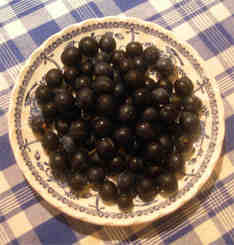Fermented sloe gin recipe: a new approach to making sloe gin
Posted by Fiona Nevile in Liqueurs | 52 comments
A dish of innocent ripe sloes waiting to be transmorigified
I love sloe gin and like most other sloe gin makers am keen to make a great brew. I hate to admit it but it would be great to impress my liqueur making guru, Gilbert. This recipe gives me the possiblity of two great outcomes. This new technique may produce a superb sloe gin opera or rolling of drums.
Colin Boswell wrote, “The secret of a good sloe gin is the extent to which the very high natural tannin content plus its other constituents have been extracted. I have found that replicating, as perhaps you have above (that’s me!), red wine production by fermenting the sloes on their skins makes an outstanding sloe gin. What you must beware of is that too high a concentration of sugar will kill the yeast and no fermentation will take place.
Layer 2 inches of frozen sloes interspaced with 3 tablespoons of sugar then another 2 inches of sloes and so forth in a fermentation bucket. Add a port wine or high alcohol yeast, probably fermenting out to 14deg. The more technical can measure the specific gravity before and after fermentation to gauge the alcohol content and how much sugar needs to be added.
Stand in a warm place, keep a close eye on fermentation and add small amounts of sugar until fermentation ceases.
Fermenting will of course raise the alcohol content but more importantly it extracts the full flavours of the sloes which other methods fail to do.
I would greatly appreciate the views of an experienced amateur winemaker on this.”
We make wine but are in no way experienced winemakers. So I couldn’t comment intelligently on the method. Instead I decided to give this method a go. I must admit I never would have considered fermenting the sloes before adding the gin but I haven’t been thinking laterally as regards sloe gin. I can see the wisdom behind this method, upping the alcohol level before adding the gin. As Colin says, why let the sloes become imbued with the gin – unless you are going to use the sloes for something else (they can be added to mince pies, Christmas cake, chocolate or the boozy crumble that will have you mother-in-law finally sleeping in a heap under the table).
For this experiment I am using 2 pounds of sloes (900g). I am planning to use the fermented sloes for sloe sherry.
You can get a range of good red wine yeasts online from many sources. I use the art of brewing .
I asked Colin for the ratio mix of fermented sloes to gin and received this reply.
“6l fermented sloe juice to .4l gin, assuming sloe juice has reached 15% alcohol, will give sloe gin at 25%. 50/50 gives 27.5% alcohol. By comparison, if the sloe juice was not fermented, alcohol content at .6l/.4l gin is 16% and at 50/50 20%. The gin and sloe juice need at least two months, preferably longer but should be acceptable by Christmas.
I also recommend the addition of juniper berries, 10 to a gallon of sloes.”
Leave a reply





My Sloe Gin is in great demand by friends I pick the Sloe as late as possible but still freeze them overnight. I then lay them out in a shallow baking pan and crush them suing a suitable utensil. The Sloes are then put into a large jar to approx half full and covered with sugar half the weigh of the sloe s and finish by filling the jar with a quality Gordon’s Gin. Tund over each day until all the sugar has dissolved
It can be bottled after two months but if not wanted immediately leave until required. It improves with age ( unlike me ) I have found
I some things which i have been wondering about were whether it is safe to use the fermented sloes strained off in Sloe Sherry? I wondered about making it richer so thought about adding extra sloes (late season so probably better quality) to the wine – spirit base. Also I really recommend trying cherry pip vodka – we got about 20kg of cherries off our tree and spent a couple of evenings destoning them. At the end i thought I’d try mixing them with some sugar and vodka – the result was amazing: pure almond flavour, but much less cloying than Amaretto and disrt cheap. Next year I’ll do it on a MUCH bigger scale. So some of that will be ging into the sloe gin as well! 😉